We're in this together, a message from our CEO
A word from our leaders. You're not alone and during these uncertain times, it's important now more than ever to remain connected.
Competitive intelligence goes nowhere when presented in nightmare spreadsheets and grimy post-it notes; you need clear, concise reports your teams will love.
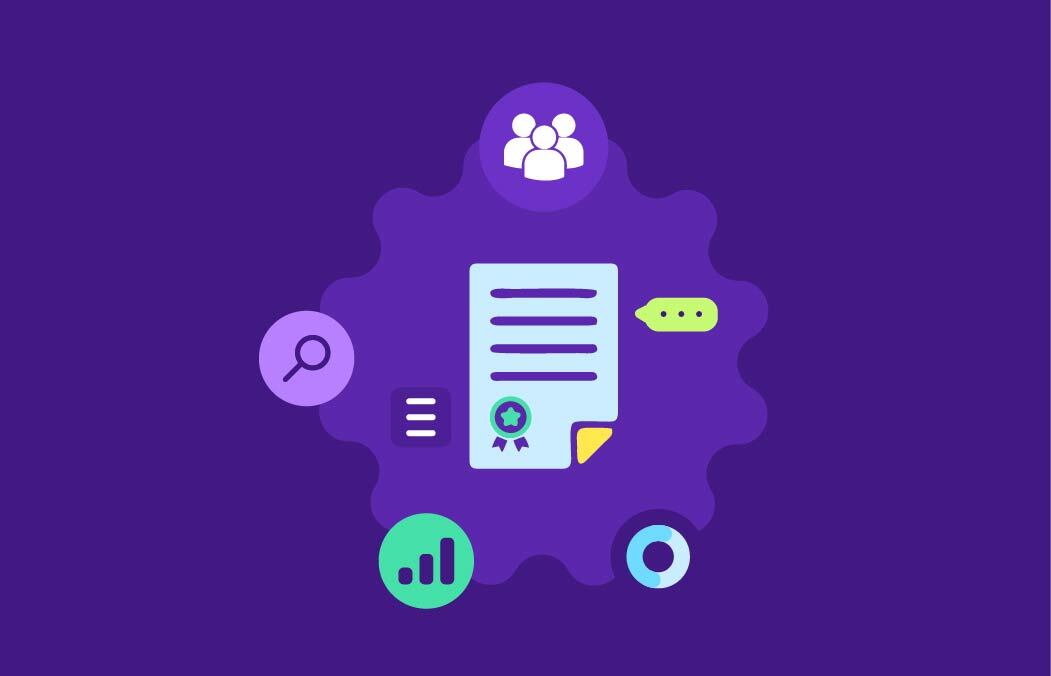
Picture this — your team's personal reconnaissance operative, subtly gathering information while you juggle all your daily work.
This crafty intelligence agent catches your competitors’ product updates, financial shifts, company acquisitions, significant website updates, consumer feedback, and myriad other details weaving an invaluable safety net for your brand.
But what use are these insights if they're scattered across nightmare spreadsheets and smudged sticky notes, collecting digital dust?
The power of competitive intelligence lies not just in the gathering, but in the clear, concise, and comprehensive reporting of it; and the actions you take because of it.
Think of your intelligence reports as private security briefings –succinct nuggets of intel your team is eager to receive. No need to keep the ace up your sleeve!
While you may have taken on competitive intelligence to enable sales and product marketing, your entire company will be stronger and more united when each team is powered by the right reports. And they’ll have you to thank for it.
Sales Battlecards are the trailblazers of competitive intelligence reports, but you likely have those figured out. Today, we’ll discover seven competitive intelligence reports to empower your other teams.
Your competitive intelligence reports, or “intelligence briefs” to keep our spy analogy, 🕵️ are unique to you and customized for each team, but here are some of the reports Kompyte users love.
And because your teams might need a little convincing to try something new (don’t we all!?), we’ll also cover the overall purpose of each report and the benefits the team will enjoy when they use them. And, we've included examples of Reports we've made using Kompyte.
And while we'll talk about where to find each of these insights, you may already be tracking all the recommended data sources. All you need to do to empower your teams is create an easy-to-use Report with information relevant to each!
Assuming you are using competitive intelligence automation, most of the sources you need to track will update your Reports automatically.
Purpose: This report gives your HR team insight into which roles your competitors are filling, and how they're attracting talent, allowing your team to be more strategic in hiring. You might include:
Fine tune your own recruiting strategy when you see how competitors attract talent. Find this on competitor websites, job boards, and LinkedIn. Some companies also have recruiting-specific social media accounts, particularly on Instagram.
What are your competitors doing to attract and keep top talent? Use what you learn to improve your own company culture, benefits, and perks. Find this on Glassdoor, Indeed, and social media.
Essential for keeping your compensation packages competitive and attractive. Look at industry reports, salary surveys, and Glassdoor.
Improve your own programs when you see what others offer. Watch competitor websites and social profiles as well as LinkedIn and industry news.
Benchmark your own efforts and watch industry trends. Look for this on competitor websites, corporate social responsibility reports, diversity and inclusion reports, and Glassdoor.
Keep an eye on industry trends and be aware of opportunities to attract top talent from competitors. Watch industry news, press releases, and social media platforms.
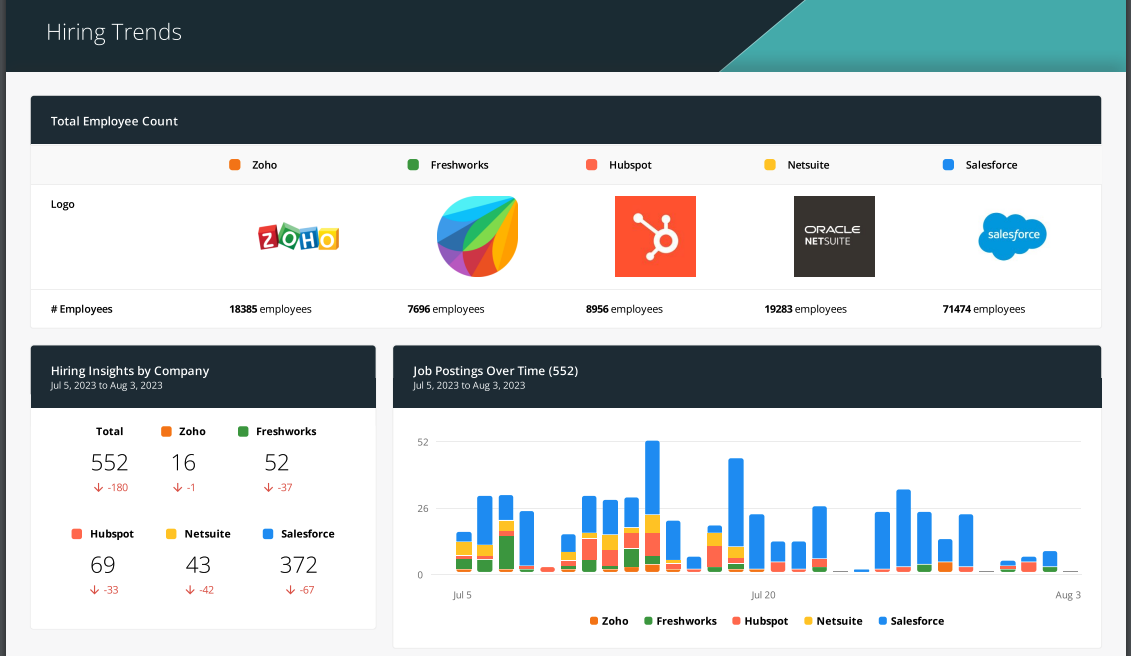
Your marketing team needs to understand not just what the market wants, but what other voices are saying and how a shared audience responds. Here are some insights you might include to help them do their best work:
Identify successful tactics and adapt them for your own use. Find these in changes to competitor websites, social media updates, and in email marketing.
Understand current market narrative and adjust your own messaging accordingly. Learn about this from competitor blog posts, social content, and ads.
See what’s working and what customers are saying in reply. Track your competitors’ social media profiles.
Identify weaknesses in competitor offerings that you can address in your own marketing. Find this in online reviews, forums, and social media comments.
Use what you learn here to compete for search engine rankings. SEO tools and website analysis can give you this information. Also watch for common themes in blog posts.
Lean about successful strategies and create your own. Keep an eye on competitor websites, emails, ads they run, and social media profiles.
Why it's essential: It helps your marketing team create compelling, differentiated narratives. By understanding competitor tactics and audience responses, they can craft strategies that resonate with your shared audience and highlight your unique value proposition.
This report in Kompyte automatically pulls in social media activity and engagement across all competitors.
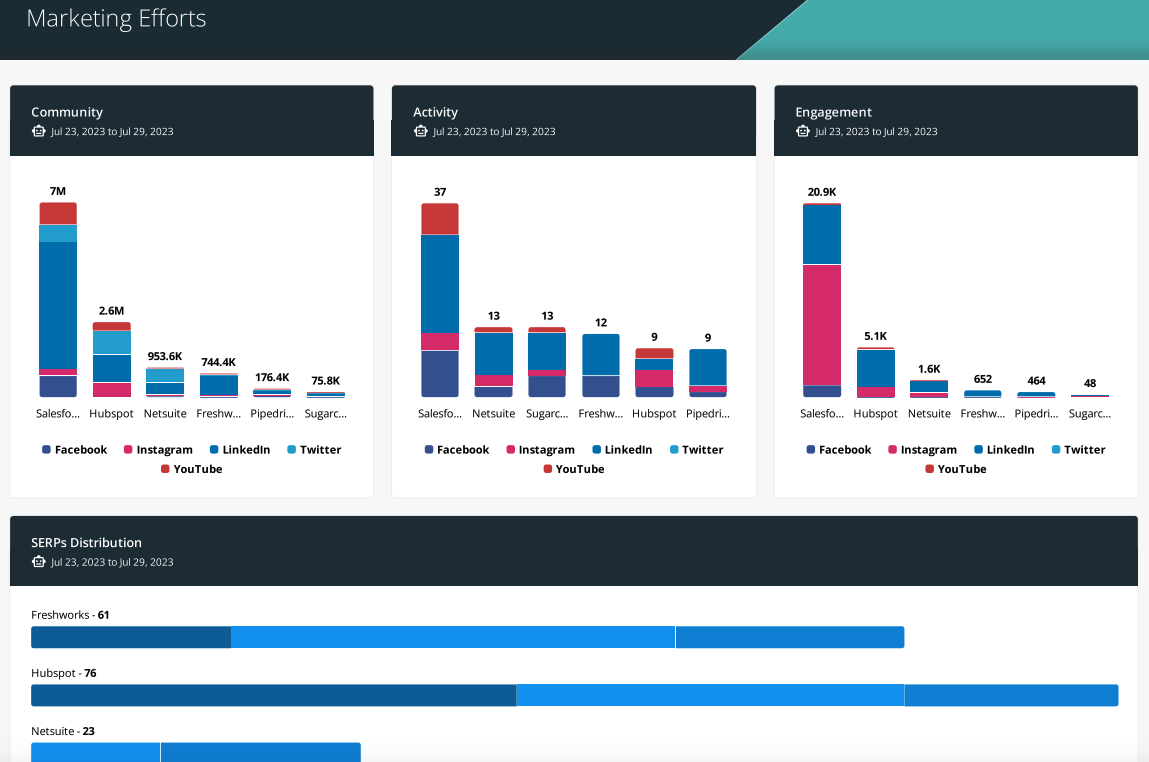
Your goal here is to provide a comprehensive understanding of the competitive landscape at the highest level.
The report is pivotal in assessing the company's position in the market relative to its competitors, and enables executives to understand and anticipate competitors' strategies, from their financial health to product development, partnerships, and changes in leadership.
The big-picture competitor view can help identify potential threats and opportunities, such as shifts in the market, emerging trends, regulatory challenges, or potential areas for growth. With this information, executives can make informed strategic decisions about resource allocation, business strategy, partnerships, product development, and more.
An in-depth understanding of competitors' actions and strategies enables proactive, rather than reactive, decision-making. The competitive intelligence report equips executives with the insights necessary to navigate the business landscape, capitalize on opportunities, and steer the company towards success. Here’s what you might include:
Changes in company size, mergers and acquisitions, new funding - they all reveal something about the plans and financial health of your competitors. Look for this information on company websites, press releases, SEC filings, and financial news outlets.
Keep an eye on competitors’ market presence and reputation, responding to any shifts in the landscape. Watch news outlets, industry publications, social media, and Google Alerts.
Partnerships and collaborations can weaken your competitive advantage. Plan your own strategic alliances in response, if needed. Watch company websites, product reviews, patent filings, social media, and industry news.
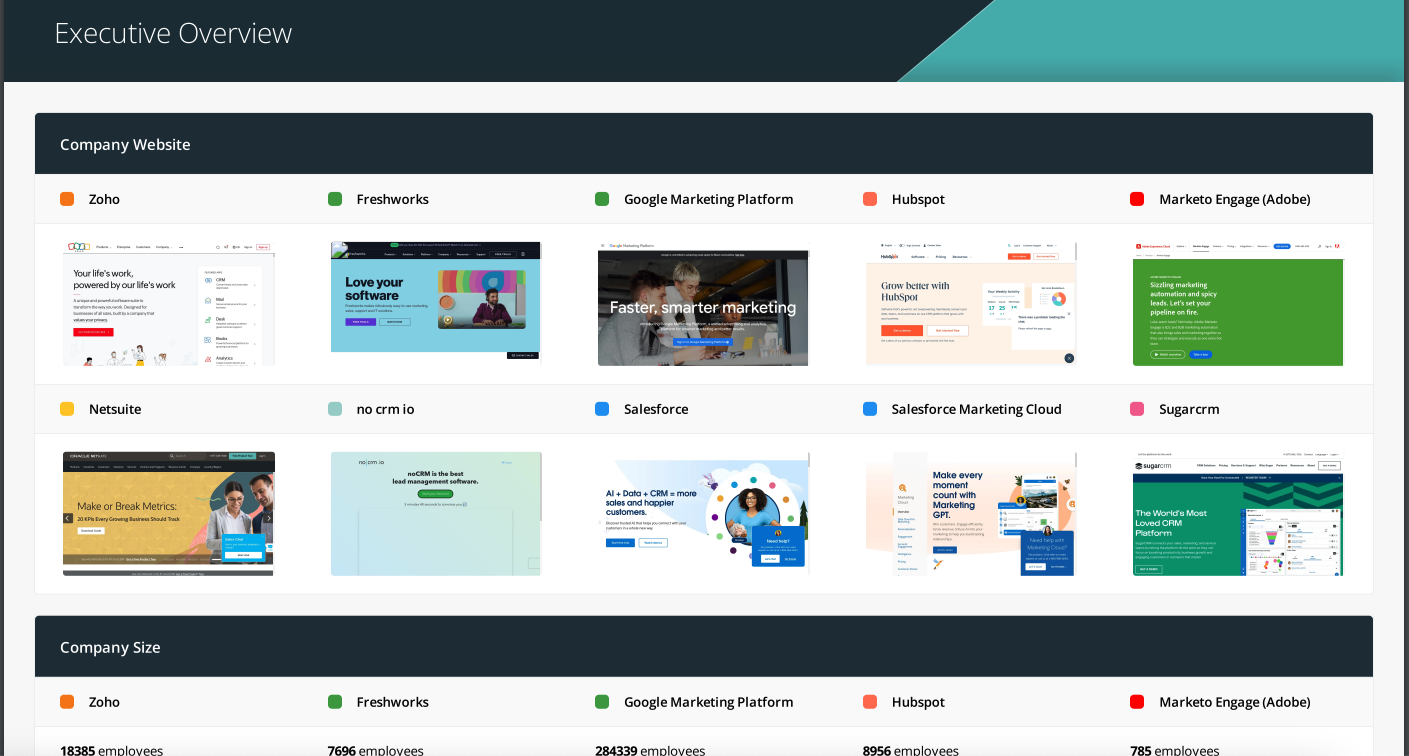
Pssst.... you can have reports like this that update automatically. Get a demo and see how:
The team responsible for leveraging events will appreciate this intel that helps them to better execute their own events. They’ll also look for insights into how competitors are approaching events, from who is speaking and on which topics, to partnerships and sponsorships.
If someone from the team is attending, knowing where and when competitors are speaking or exhibiting provides an opportunity for some real-life secret agent moves (all done openly and ethically, of course!).
Ultimately, an informed events team can create experiences that not only stand out from the competition but also resonate with the target audience, thereby contributing to the overall business goals. And they can make the most of events their competitors attend. Here’s what you might include:
Knowing what type of events your competitors organize can help you plan your own. Look at company and event websites, social media, and industry newsletters to spot those.
Identify key themes and topics to inform plans for your own events. Watch event agendas, social media profiles, and company websites.
Strategize where you’ll place your booth for maximum exposure, and plan to stop by and say hello (make sure you let them know who you work for). Look for event floor maps, social media updates, and event apps.
Find your own sponsorship opportunities and spot partnerships. Look at company press releases, event websites, and social media profiles.
Learn what worked and what did to make your own event even better. Look for social media updates, event reviews, and industry blogs.
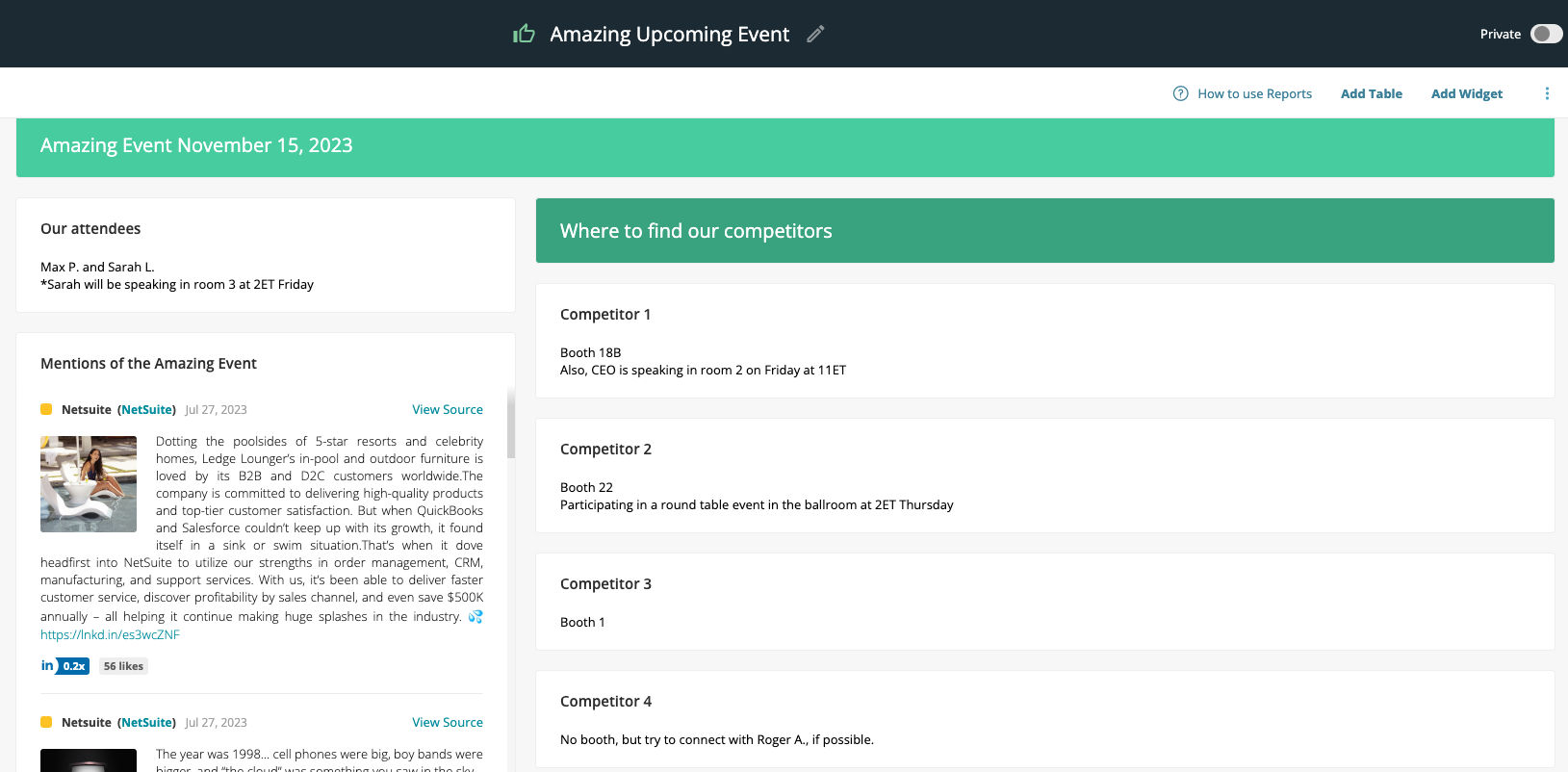
The product team has the task of identifying gaps in the market, leveraging competitor weaknesses, and understanding emerging trends. They also need to make sure pricing is competitive and that their roadmap is taking them in the right direction. Items to include in their report:
Identify gaps in your own offerings and inform stronger roadmaps. You’ll find this information on competitor websites, emails, news outlets, and social media.
Know your competitors’ strengths and weaknesses to better position and build your own offerings. Look to review websites, forums, and social media updates.
Benchmark your own pricing and plan pricing for new products with this information you’ll find on competitor websites, in industry reports, and through market research.
These reveal where competitors are focusing on innovation. Keep an eye on patent databases and press releases for these updates.
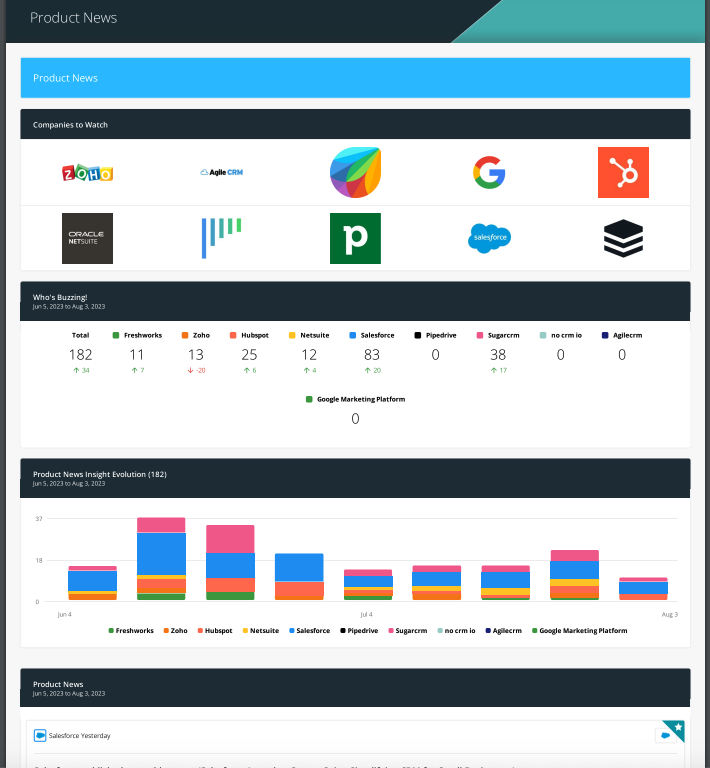
Innovation moves fast, and it’s easy to miss a move by the competition. Avoid being outpaced by competitors and find areas for innovation by looking at:
These can reveal all-new technologies and market-disrupting technologies. The sooner you know about them, the better. Watch company patent applications, industry reports, press releases and competitor blog posts.
Alliances between competitors can change market dynamics. Keep an eye on possible disruptors by tracking company press releases, news articles, and industry reports.
Are you spending enough? Too much? Knowing what your competitors invest in innovation can help you understand their focus as well. Look at annual reports, investor presentations, and financial news.
Learn from the experience of others and refine your own strategy. You’ll find this in case studies, news reports, and post-mortems.
Sometimes “innovation” means anticipating and preparing for upcoming compliance changes. Watch government and regulatory sites, legal news, and industry reports.
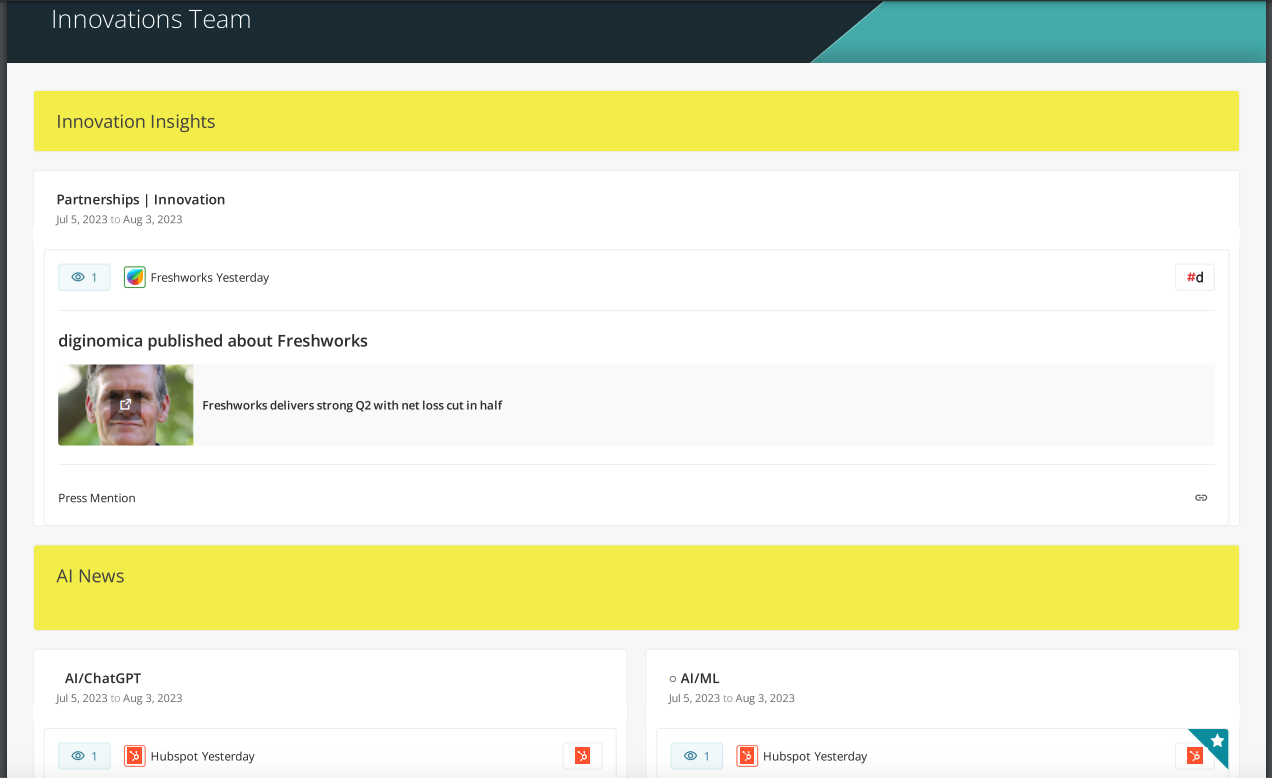
When your brand team understands competitors’ branding efforts, they can quickly spot trends, gaps, and opportunities in the marketplace, allowing them to differentiate and align with customer expectations and needs. It'll also enable proactive reputation management, keeping the brand relevant and competitive.
The brand team will want to see:
Stand out when you find your differentiating factors and stay ahead when you anticipate market shifts. Look at competitor websites, social media profiles, advertising, and press releases. Because these can change quickly, make sure you are watching for changes daily.
What customers say about your own brand and competitor brands helps to identify pain points and what customers like about the brands. Monitor customer reviews and social media comments.
Make sure your brand remains relevant and appealing when you know what design trends are working in your industry. Look at design blogs and competitor websites and social media.
Learn from successes and failures when your competitors have a crisis or opportunity. News articles, case studies, and social media are your best sources here.
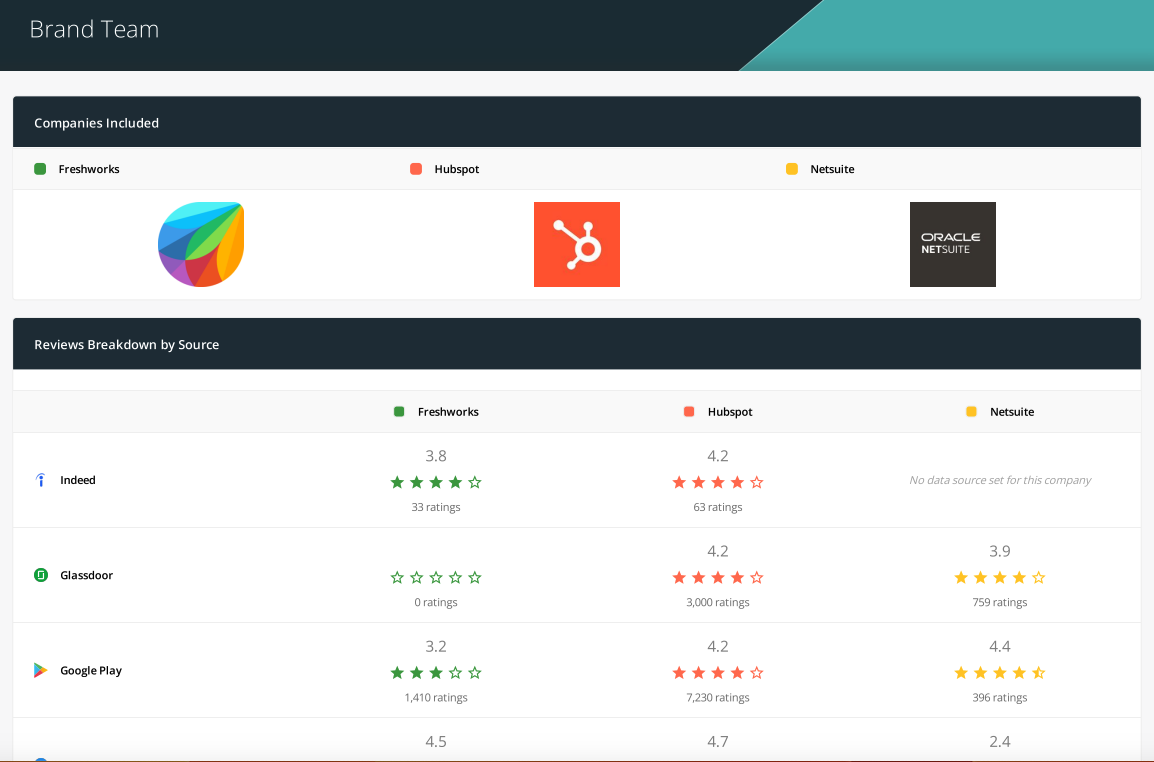
You want to make a bigger impact in your organization, and you have the tools to do it! You just need to put them together in a way that they’ll use. To that end, we’ve created a competitive intelligence report template just for you.
Of course, it’s easier to create and maintain these reports automatically inside Kompyte, so if that sounds like something you want to explore, get a demo now!
Talk to your teams. Ask each one what they'd like to see in a custom report. Don’t be surprised if the only reply is a blank stare. After all, they're busy, too, and may see this as one more thing they need to do. No need to worry - you have lots of ideas for them right in this article!
Soon, they begin to see the puzzle pieces sliding into place. When they see how little they need to do to benefit, their defenses crumble, and what’s left is excitement–and maybe even a little gratitude.
Now you know you’ve not only contributed to the growth of each team, but you’ve also sparked a revolution. One where competitive intelligence propels you all forward together. Who knew a simple report could have such power?!
A competitive intelligence report is a comprehensive overview of your company’s competitive landscape broken down into different business segments. It may cover employment, marketing and brand, executive leadership, events, and product development.
You can use a pre-existing template or drop your findings into a Google spreadsheet and compare your competitors against one another using pie graphs, charts, or other visualizations that will help your teammates better understand the data.
You will likely have brand, marketing, HR, events, and product sections. You might even have sections on social following, executives, and recent news articles.
To get the most comprehensive report, you will want to source data from several locations like online publications, social media, competitor and prospect websites, review sites, and more.
A word from our leaders. You're not alone and during these uncertain times, it's important now more than ever to remain connected.
Obviously knowledge is a big part of business success. But as crucial as knowledge is, knowing on its own only goes so far. To make a difference,...
Warning signs that your messaging is outdated - what you need to do going into 2024. 10-min read
Be the first to know about new B2B SaaS Marketing insights to build or refine your marketing function with the tools and knowledge of today’s industry.